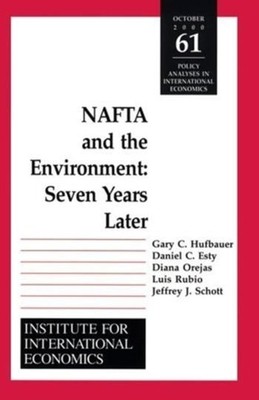
- We will send in 10–14 business days.
- Author: Gary Clyde Hufbauer
- Publisher: Peterson Institute for International Economics
- ISBN-10: 0881322997
- ISBN-13: 9780881322996
- Format: 15.2 x 22.9 x 0.5 cm, minkšti viršeliai
- Language: English
- SAVE -10% with code: EXTRA
Reviews
Description
When NAFTA became a political reality, environmentalists reacted. They argued, among other things, that commercial competition would weaken environmental standards in all three countries, and that industrial growth in Mexico would further damage its weak environmental infrastructure. The demands for action against current and potential abuses posed a serious obstacle to the completion of NAFTA negotiations. A side accord-the North American Agreement on Environmental Cooperation (NAAEC)-helped alleviate some of these concerns. But in the aftermath of NAFTA's economic success, poor living conditions persist in most of Mexico. Many environmental groups blame NAFTA and, drawing on its experience, now oppose new trade initiatives. Does the NAFTA record on the environment since 1994 justify its criticism? Seven years is too short to redress decades of environmental abuse, but it is not too soon to assess NAFTA's achievements and shortcomings in meeting its environmental objectives. In this analysis, the authors review (1) the environmental provisions of the NAFTA; (2) the NAAEC; (3) the situation at the US-Mexican border; and (4) the trends in North American environmental policy. They emphasize that the environmental problems of North America were not the result of NAFTA nor was the NAAEC devised to address all of them. But with its huge success in expanding free trade, NAFTA has concentrated population and environmental abuse at the US Mexico border-where it is most visible to Americans.
EXTRA 10 % discount with code: EXTRA
The promotion ends in 21d.06:12:13
The discount code is valid when purchasing from 10 €. Discounts do not stack.
- Author: Gary Clyde Hufbauer
- Publisher: Peterson Institute for International Economics
- ISBN-10: 0881322997
- ISBN-13: 9780881322996
- Format: 15.2 x 22.9 x 0.5 cm, minkšti viršeliai
- Language: English English
When NAFTA became a political reality, environmentalists reacted. They argued, among other things, that commercial competition would weaken environmental standards in all three countries, and that industrial growth in Mexico would further damage its weak environmental infrastructure. The demands for action against current and potential abuses posed a serious obstacle to the completion of NAFTA negotiations. A side accord-the North American Agreement on Environmental Cooperation (NAAEC)-helped alleviate some of these concerns. But in the aftermath of NAFTA's economic success, poor living conditions persist in most of Mexico. Many environmental groups blame NAFTA and, drawing on its experience, now oppose new trade initiatives. Does the NAFTA record on the environment since 1994 justify its criticism? Seven years is too short to redress decades of environmental abuse, but it is not too soon to assess NAFTA's achievements and shortcomings in meeting its environmental objectives. In this analysis, the authors review (1) the environmental provisions of the NAFTA; (2) the NAAEC; (3) the situation at the US-Mexican border; and (4) the trends in North American environmental policy. They emphasize that the environmental problems of North America were not the result of NAFTA nor was the NAAEC devised to address all of them. But with its huge success in expanding free trade, NAFTA has concentrated population and environmental abuse at the US Mexico border-where it is most visible to Americans.


Reviews